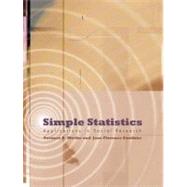
| Measurement Invalidity | |
| Sampling Problems | |
| Faulty Causal Inferences | |
| Political Influences | |
| Human Fallibility | |
| Issues in Data Preparation | |
| Why Is Data Preparation Important? | |
| Operationalization and Measurement | |
| Nominal Measurement of Qualitative Variables | |
| Measurement of Quantitative Variables | |
| Issues in Levels of Measurement | |
| Coding and Inputting Statistical Data | |
| Available Computer Software for Basic Data Analysis | |
| Displaying Data in Tables and Graphic forms | |
| The Importance Of Data Tables and Graphs | |
| Types of Tabular and Visual Presentations | |
| Tables and Graphs for Qualitative Variables | |
| Tables and Graphs for Quantitative Variables | |
| Ratios and Rates | |
| Maps of Qualitative and Quantitative Variables | |
| Hazards and Distortions in Visual Displays and Collapsing Categories | |
| Modes, Medians, Means, and More Modes and Modal Categories | |
| The Median and Other Measures of Location | |
| The Mean and Its Meaning Weighted Means | |
| Strengths and Limitations of Mean Ratings | |
| Choice of Measure of Central Tendency and Position | |
| Measures of Variation and Dispersion | |
| The Range of Scores | |
| The Variance and Standard Deviation | |
| Variances and Standard Deviations for Binary Variables | |
| Population versus Sample Variances and Standard Deviations | |
| The Normal Curve and Sampling Distributions | |
| The Normal CurveZ-Scores as Standard Scores | |
| Reading a Normal Curve Table | |
| Other Sampling Distributions | |
| Binomial Distributiont-Distribution | |
| Chi-Square Distribution | |
| F-Distribution | |
| Parameter Estimation and Confidence Intervals | |
| Sampling Distributions and the Logic of Parameter Estimation | |
| Inferences from Sampling Distributions to One Real Sample | |
| Confidence Intervals: Large Samples, Known | |
| Confidence Intervals for Population Means | |
| Confidence Intervals for Population Proportions | |
| Confidence Intervals: Small Samples and Unknown | |
| Properties of the t-Distribution | |
| Confidence Intervals for Population Means for Unknown | |
| Confidence Intervals for PopulationProportion for Unknown | |
| Introduction to Hypothesis Testing | |
| Confidence Intervals Versus Hypothesis Testing | |
| Basic Terminology and Symbols | |
| Types of Hypotheses | |
| Zone of Rejection and Critical Values | |
| Significance Levels and Errors in Decision-Making | |
| Hypothesis Testing for Means and Proportions | |
| Types of Hypothesis Testing | |
| One-Sample Tests of the Population Mean | |
| One-Sample Tests of a Population Proportion | |
| Two Sample Test of Differences in Population Means | |
| Two Sample Tests of Differences in Population Proportions | |
| Issues in Testing Statistical Hypotheses | |
| Statistical Association in Contingency Tables | |
| The Importance of Statistical Association and Contingency Tables | |
| The Structure of a Contingency Table | |
| Developing Tables of Total, Row, and Column Percentages | |
| The Rules for Interpreting a Contingency Table | |
| Specifying Causal Relations in Contingency Tables | |
| Assessing the Magnitude of Bivariate | |
| Associations in Contingency Tables | |
| Visual and Intuitive Approach | |
| The Chi-Square Test of Statistical Independence | |
| Issues in Contingency Table Analysis | |
| How Many Categories for Categorical Variables? | |
| GIGO and the Value of Theory in Identifying Variables | |
| Sample Size and Significance Tests | |
| Other Measures of Association for Categorical Variables | |
| The Analysis of Variance (ANOVA) | |
| Overview of ANOVA and When it is Used | |
| Partitioning Variation into Between and Within Group Differences | |
| Calculating the Total Variation in a Dependent Variable | |
| Calculating the Between-Group Variation | |
| Calculating the Within-Group Variation | |
| Hypothesis Testing and Measures of Association in ANOVA | |
| Testing the Hypothesis of Equality of Group Means | |
| Measures of Association in ANOVA | |
| Issues in the Analysis of Variance | |
| Correlation and Regression | |
| The Scatterplot of Two Interval/Ratio Variables | |
| The Correlation Coefficient | |
| Regression Analysis | |
| The Computation of the Regression | |
| Coefficient and Y-Intercept | |
| Goodness of Fit of a Regression Equation | |
| Hypothesis Testing and Tests of Statistical Significance | |
| Using Regression Analysis for Predicting Outcomes | |
| Issues in Bivariate Regression and Correlation Analysi | |
| Intro | |
| Table of Contents provided by Publisher. All Rights Reserved. |
The New copy of this book will include any supplemental materials advertised. Please check the title of the book to determine if it should include any access cards, study guides, lab manuals, CDs, etc.
The Used, Rental and eBook copies of this book are not guaranteed to include any supplemental materials. Typically, only the book itself is included. This is true even if the title states it includes any access cards, study guides, lab manuals, CDs, etc.